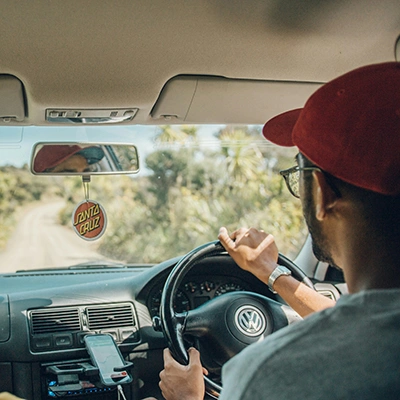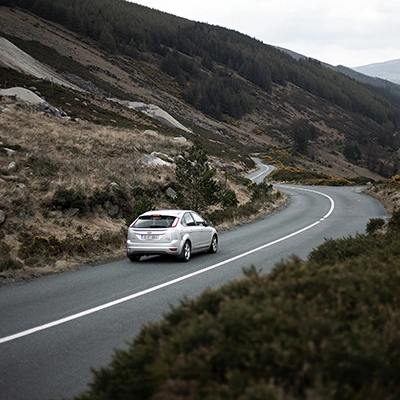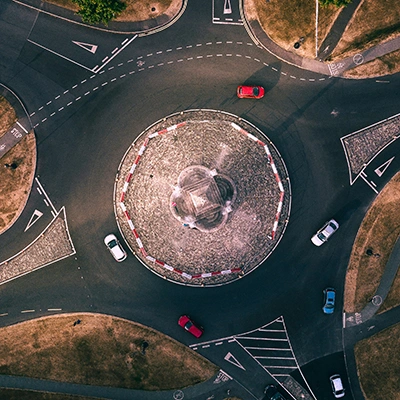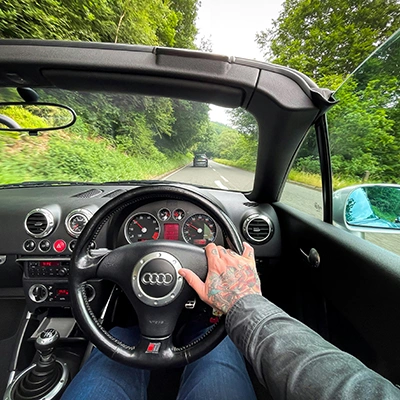Are you planning a trip to a destination where they drive on the wrong side of the road? Sorry, I mean the left side of the road. If you're a little freaked out about doing this (like I was), rest assured that it can be done safely with minimal stress.
A few years ago, my husband and I took a trip to Ireland. It's absolutely beautiful there, and one of the best ways to see as much as possible in little time is to rent a car and set out on your own.
That being said, driving on the opposite side of the road is an adjustment. Also, the driver's side is reversed, so the steering wheel is on the right side of the car. We were in Ireland for nine days, and every single morning, we'd walk to the wrong side of the car. The driver for the day walked to the passenger side and vice versa. Old habits die hard.
And yet, we managed to get through our trip in one piece, successfully navigating the beautiful Irish countryside from the seemingly unnatural vantage point of the left lane.
I did it, and you can too.
Countries Driving on the Left
If you think you will never encounter a situation where you'll be driving on the left, you might be surprised. Most of the world drives on the right (my personal preference), but about one-third of the world’s countries require you to drive on the left side of the road.
Here's a quick listing of just a few:
- Australia
- New Zealand
- England
- Ireland
- Scotland
- Wales
- Northern Ireland
- India
- Hong Kong
- Indonesia
- Japan
- Singapore
- Thailand
- Bahamas
- Barbados
- Bermuda
- Cayman Islands
- Jamaica
- Saint Lucia
- Turks and Caicos
- Virgin Islands (U.S. and British)
- Kenya
- South Africa
23 Tips for Driving on the Left Side of the Road
If you're traveling to a country that drives on the left side of the road and feeling anxious about safely driving, we've collected the best tips from experts, our own experiences, and advice from seasoned travelers.
1. Choose an automatic transmission when you reserve your rental car.
Now is not the time to learn how to drive a stick (if you don't know already). If you do know how to drive a manual transmission, remember that you will have to change gears with your left hand, because the steering wheel is on the right side of the car.
2. When driving on the interstate, highway, or motorway, the passing lane is the right lane, not the left.
Slower traffic keeps left, and you want to stay in the left lane unless you are passing. This was pretty easy to get used to.
3. Always remember, “left to left.”
This one sounds weird, but it works. Intersections are the trickiest part of driving on the left. When you are approaching an intersection that requires you to make a turn (whether right or left), repeat this mantra to yourself “left to left.”
This works no matter which way you are turning. You have to stay left — always.
The biggest challenge for me was making left turns. I found I wanted to cross traffic as I normally would here in the U.S.
4. Remember to look both ways, especially when turning right.
You're crossing traffic when you make a right turn, so you've got to remember to look both ways. Tip #3 helps with this. Too many trips have been ruined because of a collision where traffic came from a different angle than expected.
5. Let technology navigate.
Get an international phone plan so that you can use a mapping app, or take or rent a GPS. Chances are you won't know where you are going, and letting technology navigate means you have one less thing to worry about. Remembering a new set of driving rules while also trying to navigate on your own is a tough combo.
6. Plan your route and set up navigation ahead of time.
Having a general idea of where you’re going before you ever get in the car can make driving that much easier. Instead of fiddling with your phone or the GPS while you’re driving — never a safe decision — program your route in advance and get to your destination safely.
7. Be prepared for roundabouts.
You may not encounter a roundabout where you’re going, but we ran into them frequently in Ireland. Thankfully, we were used to driving in them because our hometown has quite a few.
During our trip to Ireland, we ran into some Americans who had never seen a roundabout, and they were rather confused by them.
When entering a roundabout — sometimes called a rotary — you need to yield to oncoming traffic. Cars already in the roundabout have the right of way, so once you’re in the circle, keep driving.
Go through them slowly, and remember, they flow to the left, not the right, when you're driving on the left side of the road.
8. Drive with a co-pilot.
When possible, it's better to have a passenger also paying attention. It's the one time it's helpful to have a backseat driver (don't tell my husband I said that). They can help you find your next turn, control the music and temperature, and generally help you stay alert.
9. Allow extra time.
Any time you try something new, you need to allow yourself time to practice and adjust. You might find you drive more slowly or cautiously if it’s your first time on the left-hand side.
Also, by giving yourself more time, you’re less likely to feel rushed to stay on schedule. When you can take your time and focus on the drive rather than not being late, you improve your odds of driving more safely.
10. Don't distract yourself.

Put your phone in your bag or turn off notifications if you’re using it for directions. You might also turn off the radio until you feel more comfortable. Don’t eat while you drive, either.
Treat it like when you’re a teenager learning to drive.
11. Watch for pedestrians.
When you’re hyper-focused on driving properly, it can be easy to miss some of the other goings-on. Keep an eye out for pedestrians.
It also helps to know who has the right of way at your destination — you as the driver or the pedestrian crossing the street. Remember that they may be walking from a different direction than you’re used to, too.
12. Set up your mirrors before driving.
Any time you get in a new car, you need to adjust your rearview mirrors. When you’re preparing to drive on the left, remember that the angles will be different than what you’re used to at home. Blind spots may be different, so take extra time to get all your settings right.
13. Give yourself some grace.
You’re probably going to make a few mistakes. That’s part of trying something new and learning.
If you start to feel overwhelmed, pull over somewhere safe and take a few deep breaths. Maybe get out of the car and stretch your legs. Give yourself a pep talk. Remember that there was a time when you learned to drive at home. You can do it again.
Take it slow, be safe, and you’ll do just fine.
14. Buy insurance.
Just because you have car insurance at home doesn’t mean you’re covered overseas (kind of like health insurance). When you book your rental car, ask the agency about insurance for foreign visitors. Some countries only allow you to get car insurance if you have an international driver’s permit.
It’s also worth looking into travel insurance with coverage for rental car damage. Some plans offer rental insurance in addition to or in place of the insurance you might have at home.
15. Get to know the features of your car before driving.
Part of driving safely, regardless of whether it’s on the right- or left-hand side of the road, is knowing the basics of how your car works.
Before you hit the road, figure out how to turn on the headlights and windshield wipers. Locate the parking brake. Take note of the pedals so you know which one is the clutch versus the brake versus the accelerator.
16. Familiarize yourself with the local driving laws and traffic signs ahead of time.
Traffic signs and signals vary by country, and some places have quirky laws you’ll want to learn before you get behind the wheel.
Spanish law states that you cannot drive barefoot or in flip-flops or other open-toed shoes. Driving in Germany means you must carry a first-aid kit in your vehicle at all times. In South Africa, animals have the right way. And in the United Kingdom, you can’t even use your phone to pay in a drive-through.
17. Slow down.
Drive slower than you normally would until you get the hang of your car and driving on the left. Your reaction time might not be what it usually is. Give yourself time to adjust.
18. Try to stay on the left side while parking.
Left-hand turns are easier when you’re new to driving on the left. It helps you avoid crossing oncoming traffic.
With that in mind, park on the left side, too, if possible. It’ll make coming and going from the shops or an attraction less stressful.
19. Try to refuel at left-hand side garages.
Similar to our last tip, refueling at a gas (or petrol) station on the left-hand side of the road will make your life easier. There’s less traffic to contend with if you’re making a left-hand turn into the station or back onto the road once you’ve filled your tank.
 20. Be mindful of driving habits on smaller, narrow roads.
20. Be mindful of driving habits on smaller, narrow roads.
In some countries, especially those with lots of narrow roads, it’s common to drive closer to the center line and only move over when there’s oncoming traffic. This can be disconcerting to the newer driver. Stay alert and be prepared to adjust quickly.
It can also help to make a mental note as you drive where any pull-offs are. Some narrow lanes may only be wide enough for one car. Someone — perhaps you — will need to reverse to a gap in the fence or hedge to let the other driver pass by.
21. Watch out for the edge of the road.
As someone explained on Trip Advisor, when you drive on the right, like in the U.S., you’re used to the right edge of the lane or road being blocked by the front of your car. That scenario is switched when you’re driving on the other side of the road, though.
When you’re driving in England, for example, you’re now on the right side of the car but the left side of the road. That means your visual cues for where the edge of the road is have changed.
Give your brain a chance to adjust to the change of perspective. “Find a place where you can safely stop the car and see the left edge of a lane, road, or parking lot stretch out in front of you. Note where the lane edge seems to disappear on the front of the car,” said the Trip Advisor commenter. “Get out of the car and walk around and look at how far you are from the edge. If you are too close or too far from the edge, move the car and repeat. Once you adjust to how the lane edge looks relative to the front of the car, you will be able to judge where you are in the lane."
22. Align your seat with the driver in front of you.
This is another tip for ensuring your car is oriented properly in the lane. Align your driver's seat with the driver's seat of the car in front of you. This will allow you to see where your car should be relative to the center line, something that can feel unnatural when you first drive on the left.
23. Watch for cyclists.
Driving on the opposite side of the road is difficult enough. If you're visiting somewhere with a strong cycling culture, it's important to include cyclists on your list of things to watch out for as you drive.
It might also help to learn a few road rules for cyclists so you know how they’ll (probably) react to certain situations on the road. For example, are they expected to stay on pedestrian paths or the road with you? Who has the right of way at an intersection? Are there hand signals they could use to indicate when they’re turning or stopping, and if so, what are they?
Final Thoughts on Driving on the Left Side of the Road
Now that you have all the best tips for driving on the left, you’re almost ready to hit the road!
One final thought: Have you thought about what you would do if you had an accident or got hurt while driving overseas? Consider purchasing travel insurance and take the worry out of traveling.
Seven Corners offers trip protection plans, which cover your trip costs (if you must cancel, interrupt or delay your trip), medical expenses (your health insurance in the U.S. may not cover you abroad), and your luggage (it might get delayed, lost, or stolen).
Get a quick quote online or talk to one of our licensed agents to find the best plan for your international adventure.


